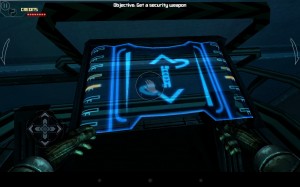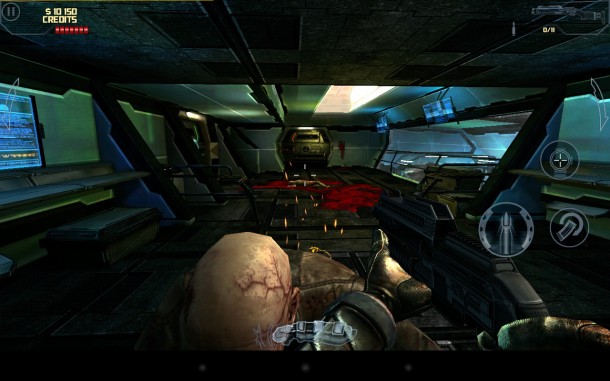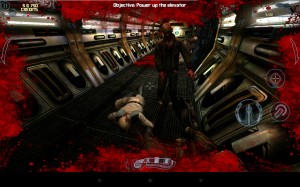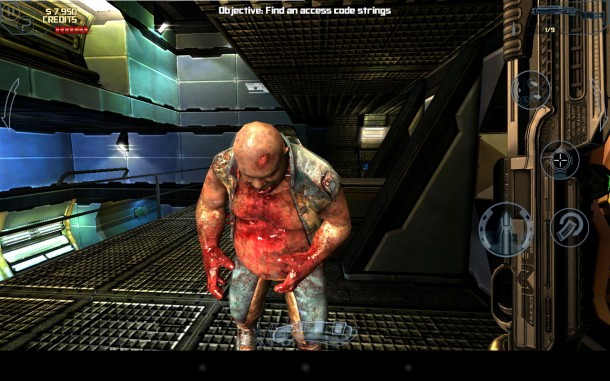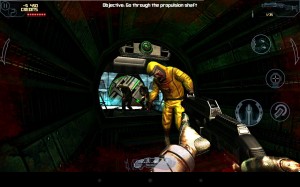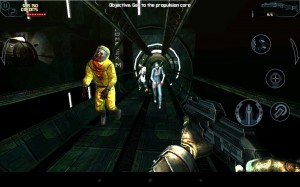Why are developers flogging a dead horse long after its corpse has withered away? Zombies tend to make for the least imaginative premise for games out there, and gaming platforms are saturated with the stuff. They also make for staid gameplay: by their very definition, the undead aren’t great at thinking on their feet or even moving quickly on them either — so what’s the draw here for studios to constantly try reinventing the wheel with this concept?
I had a lot of time to think about this as I blasted my way through Dead Effect, the latest 3D sci-fi FPS from BulkyPix. This free title packs two game modes, Google Play Games integration, a range of weapons and enough content to twiddle your thumbs through for at least five hours. I also figured that, since you probably know where this review is headed, let’s also take some time to answer some very important questions that zombie movies and games tend to ignore, and hopefully, lay them to rest once and for all.
Concept
Things have gone wrong, very wrong, aboard the ESS Meridian, a space-bound research vessel known as the ESS Meridian: an accident on the ship has botched an experiment, and apparently that’s all it takes to not only kill, but also reanimate the entire crew, complete with standard-issue zombie traits (a taste for brains, uncoordinated movement, seemingly unlimited energy). Thankfully, you’re around to help clean up the mess, repair the Meridian, steer it to safety and save the day.
How come zombies don’t eat each other, and only go after the living?
Max Brooks, author of The Zombie Survival Guide, explains that zombies are infected with a viral disease called Solanum that affects the brain, reducing it to an organ capable of only guiding its rotting host to perform a rudimentary function of sustenance: eating. The virus also allows the host to recognize other decomposing infected bodies as inedible, and so they go after living beings. TV’s The Walking Dead depicts zombies feasting on deer in the wild with as much relish as when gorging on human flesh.
Presentation
DE doesn’t look too bad, with its detailed spaceship interiors and weapons: the guns look like a lot of fun, and there’s plenty to explore aboard the ESS Meridian. However, things begin to look the same after a couple of levels, and your excitement will begin to wane soon enough. The zombies in this game seem to have been borrowed from several other similar titles — there’s your everyday tee-and-jeans guy, the quintessential pants-and-blouse lab assistant lady, the oversized armored military dude, and even the classic plus-size junkyard Bubba.
The game doesn’t sound great either. The background score isn’t remotely gripping when you can hear it, and the sounds are of the same heavy-breathing-and-gargling variety you’ve been used to since George Romero’s 1968 thriller Night of the Living Dead. The voice acting is uninspired too, and the script doesn’t add much to the linear gameplay. Rounding out the package is a dated UI with grammatical errors and poor usability that causes this game to lose even more points while it’s already on thin ice.
Levels and equipment
DE is split into several levels, each with a single key mission and minor tasks to complete before you can move on to the next one. You’ll have to explore various parts of the ship, unlock areas and get things up and running after the accident. The ship does feature some interesting interiors, but every level begins to remind you of the last one very early into the game: expect lots of permutations and combinations of dark corridors, multi-level labs and lots of elevators. Sadly, there’s nothing you’ll remember once you’ve finished this game.
As for weapons, DE has a fairly interesting selection of guns available, but unfortunately, you’ll have to spend real money to get your hands on any of them: while levels generally have about 20,000 credits (in-app currency) lying around for you to collect, a tasty alternative to the pistol/shotgun loadout you’re handed will set you back by anything between 100,000 – 600,000 credits.
In-app purchases
I’m happy to report that you don’t really have to purchase credits to play through DE, but find it ludicrous that there are stats and leaderboards in a game that allows you to buy a God mode upgrade. Similarly, you can shell out additional dough for new weapons, weapon upgrades and ammo. It’s not a particularly evil way to make money, but it’s not the smartest either. I wrote about this in a previous post that you can check out here.
How do zombies identify humans?
As it turns out, humans can see in the infrared spectrum, but only for a fraction of a second after having closed our eyes for a half hour or so. Zombies are said to be able to prolong this heat-vision, and can recognize the heat signature of humans — we generally operate at a body temperature of 98.6 deg F, while zombies assume environmental temperature. Through their eyes, it’s easy to spot humans even in the dark.
Gameplay
DE is a textbook zombie shooter: enemies are slow, lumbering, close-range-attacking goons (and very limited in variety of them, at that); headshots are the order of the day; the bigger ones take more damage. All you can do is fire at zombies and aim as best as you can on a touchscreen for their noggins. It’s sad to see developers shy away from any sort of innovation especially when foraying into this sub-genre so late in the game. 2012’s Deadlight (PC, Xbox 360) allowed players to employ many different tactics to fend off walkers, mostly without even engaging in combat — in 2D. C’mon BulkyPix, surely you can think of more ways to skin a zombie?
Apart from the single-player campaign, there’s also a survival mode, which sees you taking on waves of zombies to rack up high scores and show off to your friends. I’d have loved to have seen a co-op multiplayer mode worked in here to make things really interesting, but that’s a dream that won’t come true. DE also disappoints with a clunky aiming system and a lack of controller support. The only feature that briefly piqued my interest was bullet time, which you could use to slow down and pick off larger enemies accurately without wasting entire rounds of ammo on them. Still, that’s hardly enough to make up for a game that doesn’t make you want to face your fears again and again.
How long does it take for a zombie to rot into the ground?
It’s been propounded that zombies don’t rot, but instead erode. Unlike a dead human, zombies don’t undergo the usual decomposition processes of humans, which include rigor mortis, purtrefaction and bloating. Plus, zombies don’t heal. So when we see zombies with missing body parts and open wounds, it isn’t because its body is rotting away — its appearance is affected by cumulative physical damage. Eventually, a zombie will break, fall apart, and wear away like a pencil eraser.
Should you play DE?
Although I’ve been harsh throughout this review, Dead Effect isn’t really a bad game: it’s simple to play, mostly bug-free and has plenty of content for the great price of free. However, there aren’t any memorable moments or feats of storytelling to be found here, and it isn’t the most fun shooter out there — even if you want to stick to zombies. The House of the Dead: Overkill is a much better choice, offering significantly better gunplay and more varied environments to shoot up. Heck, there’s also the brand-new Dead Trigger 2 to check out. Skip this and dig into the others instead.
Citations: Max Brooks’ The Zombie Survival Guide and the works of The Madore Brothers



